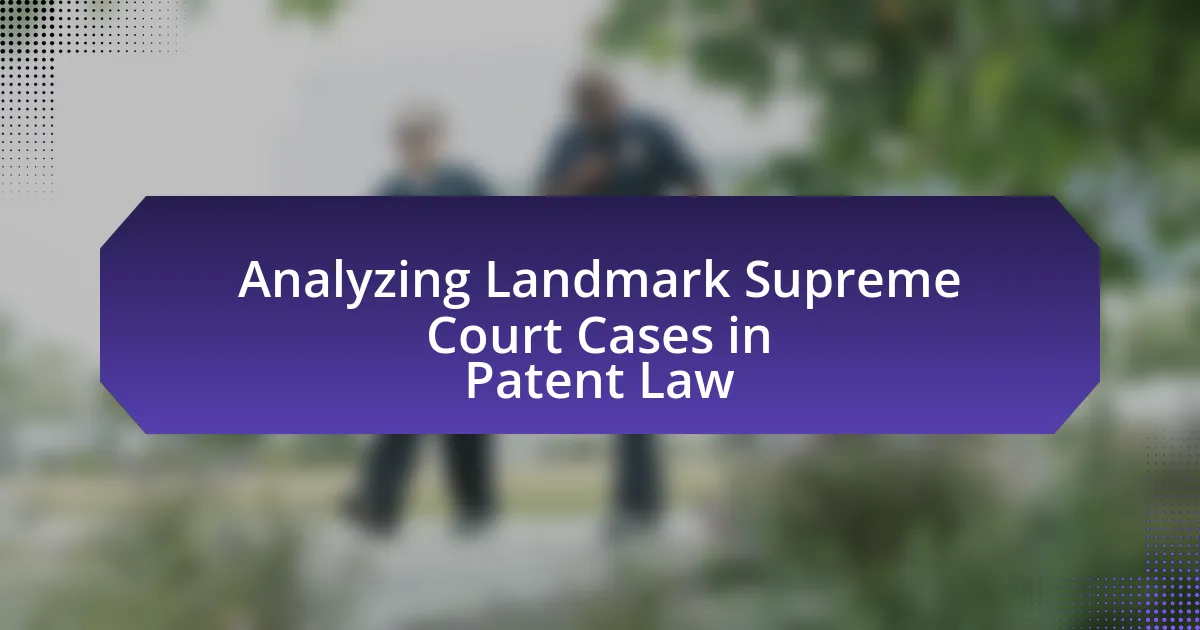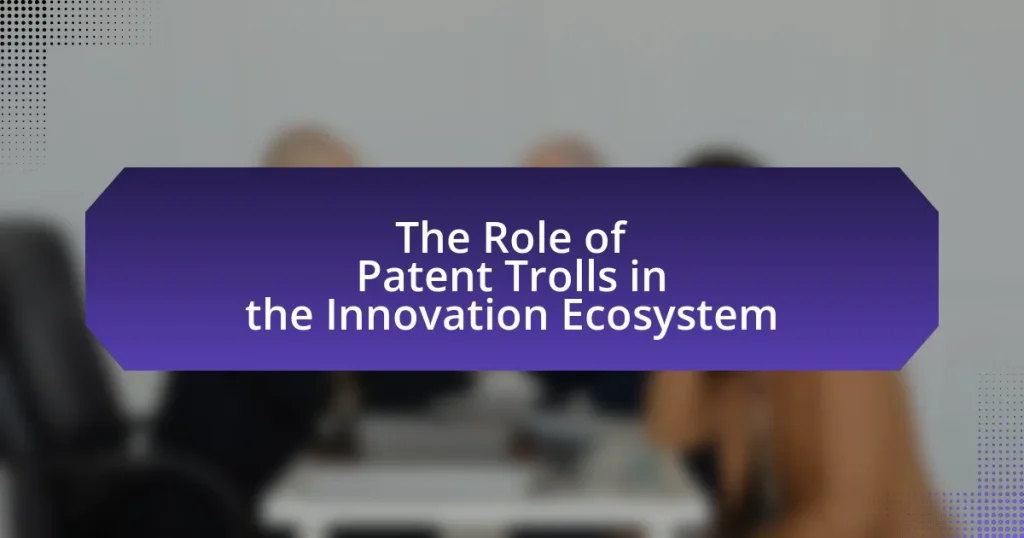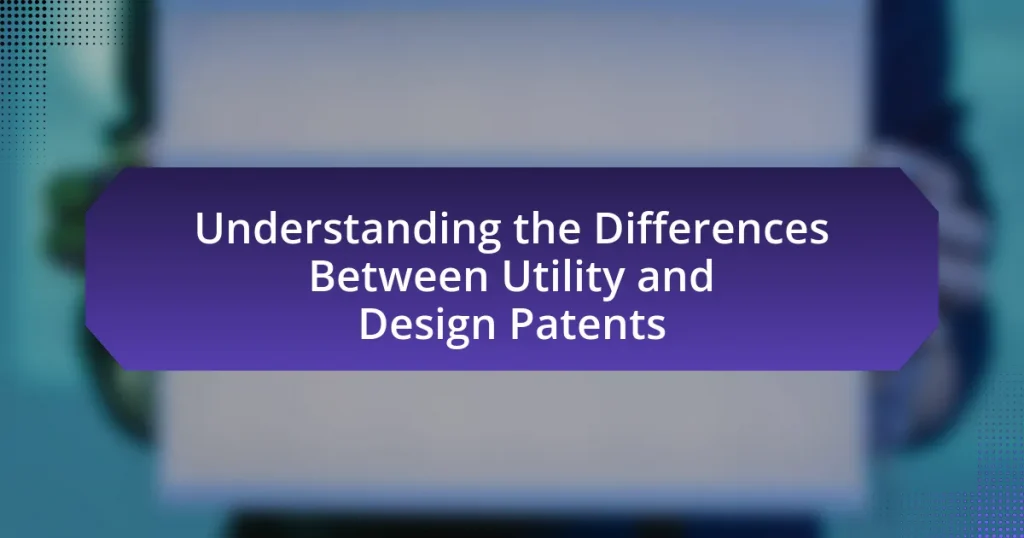The article focuses on landmark Supreme Court cases in patent law, highlighting significant rulings such as Diamond v. Chakrabarty and KSR International Co. v. Teleflex Inc., which have shaped the interpretation and enforcement of patent rights in the United States. It discusses the historical context that led to these cases, the criteria that define a case as ‘landmark’, and the legal principles established by these rulings. Additionally, the article examines how these cases influence current patent litigation, the balance between patent protection and innovation, and the implications for inventors and businesses. It also addresses trends in judicial philosophy and the role of dissenting opinions in shaping future legal interpretations.
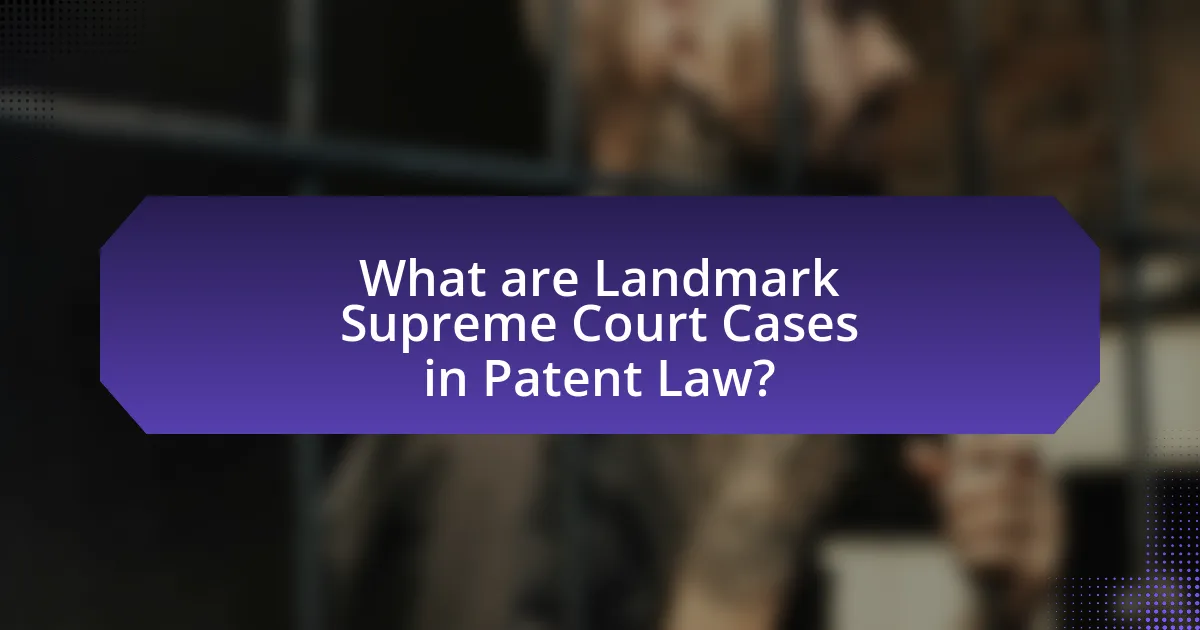
What are Landmark Supreme Court Cases in Patent Law?
Landmark Supreme Court cases in patent law include Diamond v. Chakrabarty (1980), which established that genetically modified organisms can be patented, and KSR International Co. v. Teleflex Inc. (2007), which clarified the standard for obviousness in patentability. These cases significantly shaped the interpretation of patent law in the United States, influencing how innovations are protected and the criteria for patent eligibility.
Why are these cases significant in the context of patent law?
These cases are significant in the context of patent law because they establish critical legal precedents that shape the interpretation and enforcement of patent rights. Landmark Supreme Court cases, such as Mayo Collaborative Services v. Prometheus Laboratories and Alice Corp. v. CLS Bank International, have clarified the standards for patent eligibility, particularly concerning abstract ideas and natural phenomena. For instance, the ruling in Alice emphasized the need for an inventive concept beyond mere abstract ideas, which has led to a more stringent examination of software and business method patents. These decisions influence how courts assess patent applications and litigations, impacting innovation and the balance between protecting inventors and promoting public access to ideas.
What historical events led to the emergence of these landmark cases?
The emergence of landmark Supreme Court cases in patent law was primarily influenced by the Industrial Revolution, which spurred innovation and the need for legal protection of inventions. The rapid technological advancements during the late 18th and 19th centuries, such as the steam engine and telegraph, created a surge in patent applications, highlighting the inadequacies of existing patent laws. Additionally, the establishment of the U.S. Patent Office in 1790 and subsequent legislative changes, including the Patent Act of 1836, aimed to streamline the patent process and address issues of patent validity and enforcement. These historical developments set the stage for significant Supreme Court rulings that shaped patent law, such as the 1853 case of Wheaton v. Peters, which clarified the rights of patent holders, and the 1870 case of Grant v. Raymond, which addressed the scope of patentable inventions.
How do these cases shape the current understanding of patent law?
Landmark Supreme Court cases significantly shape the current understanding of patent law by establishing precedents that clarify the scope and application of patent rights. For instance, the case of Alice Corp. v. CLS Bank International (2014) refined the criteria for patent eligibility, particularly concerning abstract ideas, which has led to stricter scrutiny of software and business method patents. This ruling has influenced subsequent decisions and patent applications, emphasizing the need for concrete technological advancements rather than mere abstract concepts. Additionally, the case of eBay Inc. v. MercExchange, L.L.C. (2006) established that the issuance of permanent injunctions in patent cases is not automatic, thereby affecting how courts evaluate remedies in patent disputes. These cases collectively inform legal interpretations and practices, guiding inventors, businesses, and legal professionals in navigating the complexities of patent law.
What criteria define a case as ‘landmark’ in patent law?
A case is defined as ‘landmark’ in patent law when it establishes significant legal precedents that influence future patent litigation and policy. Landmark cases typically involve pivotal issues such as the interpretation of patent eligibility, the scope of patent rights, or the standards for patentability. For instance, the Supreme Court’s decision in Alice Corp. v. CLS Bank International (2014) set a new standard for determining the eligibility of abstract ideas for patent protection, thereby reshaping the landscape of software patents. Such cases are recognized for their lasting impact on the legal framework governing patents and their ability to guide lower courts and patent offices in subsequent decisions.
What legal principles are established by landmark cases?
Landmark cases establish critical legal principles that shape patent law, including the doctrines of patent eligibility, non-obviousness, and the interpretation of patent claims. For instance, the Supreme Court case of Diamond v. Chakrabarty (1980) established that genetically modified organisms could be patented, affirming that living things can be considered patentable subject matter under 35 U.S.C. § 101. Additionally, the case of KSR International Co. v. Teleflex Inc. (2007) clarified the standard for non-obviousness, emphasizing that a combination of prior art could render an invention obvious if it would be apparent to a person of ordinary skill in the field. These cases illustrate how landmark rulings influence the interpretation and application of patent law, setting precedents that guide future decisions.
How do these principles influence future patent litigation?
The principles established in landmark Supreme Court cases significantly influence future patent litigation by shaping legal interpretations and standards for patentability, infringement, and enforcement. For instance, the Supreme Court’s decision in Alice Corp. v. CLS Bank International clarified the criteria for determining whether a patent claim is directed to an abstract idea, thereby impacting how lower courts assess patent eligibility. This ruling has led to an increase in challenges against patents deemed to cover abstract ideas, as seen in subsequent cases where courts have invalidated patents based on the Alice framework. Additionally, the principles from cases like eBay Inc. v. MercExchange, LLC, which addressed the standards for granting injunctions in patent cases, have influenced how courts evaluate the appropriateness of injunctive relief, affecting the strategies employed by patent holders and accused infringers alike. These precedents create a legal landscape that guides future litigation strategies, influencing both the likelihood of success in patent enforcement and the defenses available to alleged infringers.
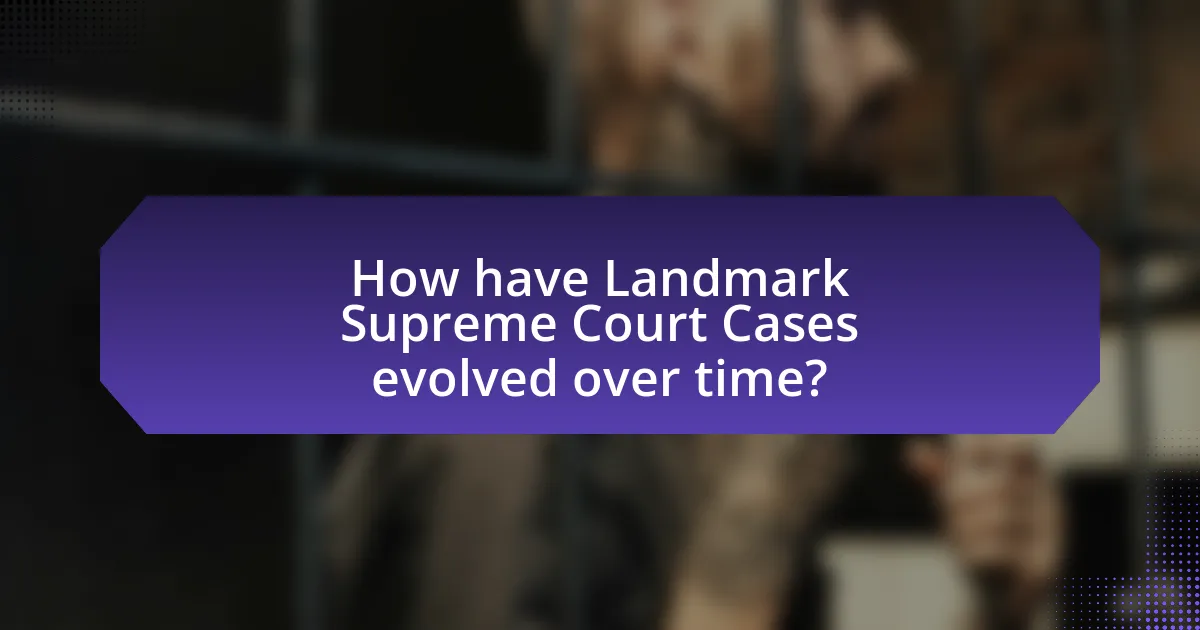
How have Landmark Supreme Court Cases evolved over time?
Landmark Supreme Court cases have evolved over time by reflecting changes in societal values, legal interpretations, and technological advancements. For instance, the evolution can be seen from the early case of Marbury v. Madison in 1803, which established judicial review, to more recent cases like Alice Corp. v. CLS Bank International in 2014, which clarified the standards for patent eligibility in light of advancements in technology. This progression illustrates how the Supreme Court adapts its rulings to address contemporary issues, such as the balance between innovation and public access to information, thereby shaping patent law in response to the evolving landscape of intellectual property.
What trends can be observed in landmark patent law cases?
Trends observed in landmark patent law cases include a shift towards stricter standards for patent eligibility and increased scrutiny of patent claims. For instance, the Supreme Court’s decision in Mayo Collaborative Services v. Prometheus Laboratories (2012) established that laws of nature cannot be patented, leading to a more rigorous examination of what constitutes a patentable invention. Additionally, the Alice Corp. v. CLS Bank International (2014) ruling further refined the criteria for software patents, emphasizing the need for an “inventive concept” beyond abstract ideas. These cases reflect a broader trend of limiting patent scope to promote innovation and prevent monopolization of fundamental scientific principles and abstract ideas.
How have technological advancements impacted these cases?
Technological advancements have significantly influenced landmark Supreme Court cases in patent law by reshaping the legal landscape surrounding intellectual property rights. For instance, the rise of digital technologies and biotechnology has led to pivotal cases such as Association for Molecular Pathology v. Myriad Genetics, where the Supreme Court ruled that naturally occurring DNA sequences could not be patented, reflecting the need to adapt patent law to modern scientific realities. Additionally, advancements in information technology have prompted cases like Alice Corp. v. CLS Bank International, which established a framework for determining the patent eligibility of software and abstract ideas, thereby impacting how patents are granted in the tech industry. These cases illustrate how evolving technologies necessitate ongoing legal interpretations and adaptations in patent law to balance innovation with public access.
What shifts in judicial philosophy are evident in recent rulings?
Recent rulings in patent law demonstrate a shift towards a more textualist and originalist interpretation of statutes, emphasizing the importance of the plain meaning of legal texts. This shift is evident in cases such as the 2021 decision in United States v. Arthrex, where the Supreme Court underscored the necessity of adhering closely to statutory language when determining the constitutionality of administrative patent judges. Additionally, the Court’s ruling in Google LLC v. Oracle America, Inc. highlighted a trend towards balancing innovation and copyright protection, reflecting a pragmatic approach to intellectual property that considers the implications for technological advancement. These rulings indicate a departure from previous judicial philosophies that may have prioritized broader interpretations or policy considerations over strict textual analysis.
What role do dissenting opinions play in landmark cases?
Dissenting opinions in landmark cases serve to provide alternative legal reasoning and perspectives that can influence future legal interpretations and reforms. These opinions often highlight potential flaws in the majority’s reasoning, thereby fostering a more comprehensive understanding of the legal issues at hand. For instance, in the landmark case of Roe v. Wade, Justice Rehnquist’s dissent emphasized the importance of states’ rights, which has been referenced in subsequent cases regarding state regulations on abortion. This illustrates how dissenting opinions can shape ongoing legal debates and inform future judicial decisions, ultimately contributing to the evolution of legal standards and principles.
How can dissenting opinions influence future legal interpretations?
Dissenting opinions can significantly influence future legal interpretations by providing alternative legal reasoning and perspectives that may be adopted in subsequent cases. These dissenting views often highlight potential flaws in the majority opinion, prompting future courts to reconsider established precedents. For instance, Justice Ruth Bader Ginsburg’s dissent in Ledbetter v. Goodyear Tire & Rubber Co. emphasized the need for legislative action on pay discrimination, which ultimately led to the Lilly Ledbetter Fair Pay Act of 2009. This illustrates how dissenting opinions can shape legal discourse and inspire changes in law and policy, thereby affecting future judicial interpretations.
What notable dissenting opinions have emerged in patent law cases?
Notable dissenting opinions in patent law cases include Justice Stephen Breyer’s dissent in the 2014 case of Association for Molecular Pathology v. Myriad Genetics, where he argued against the majority’s decision to allow the patenting of isolated DNA sequences, emphasizing the potential negative impact on scientific research and innovation. Another significant dissent came from Justice Ruth Bader Ginsburg in the 2016 case of Cuozzo Speed Technologies v. Lee, where she expressed concern over the implications of the Patent Trial and Appeal Board’s authority to invalidate patents, arguing that it undermines the stability of patent rights. These dissenting opinions highlight critical perspectives on the balance between patent rights and public interest in the evolving landscape of patent law.

What are the implications of Landmark Supreme Court Cases on innovation?
Landmark Supreme Court cases significantly influence innovation by shaping patent law and determining the scope of intellectual property rights. For instance, the 1980 case Diamond v. Chakrabarty established that genetically modified organisms could be patented, thereby encouraging biotechnological advancements. Similarly, the 2014 case Association for Molecular Pathology v. Myriad Genetics ruled that naturally occurring DNA cannot be patented, which impacted research and development in genetics by promoting open access to genetic information. These rulings illustrate how judicial interpretations of patent law can either foster or hinder innovation by affecting the incentives for research and development in various fields.
How do these cases affect the balance between patent protection and innovation?
Landmark Supreme Court cases significantly influence the balance between patent protection and innovation by shaping legal precedents that either strengthen or weaken patent rights. For instance, the Supreme Court’s decision in Mayo Collaborative Services v. Prometheus Laboratories (2012) restricted patent eligibility for certain medical diagnostic methods, thereby promoting innovation in the healthcare sector by allowing more competition and access to fundamental scientific principles. Conversely, cases like eBay Inc. v. MercExchange, L.L.C. (2006) reinforced the ability of patent holders to seek injunctions, which can deter innovation by creating barriers for competitors. These rulings illustrate how judicial interpretations of patent law can either foster a more dynamic innovation environment or create obstacles that stifle technological advancement.
What are the potential consequences for inventors and businesses?
The potential consequences for inventors and businesses include financial losses, reduced innovation, and legal challenges. Financial losses can arise from costly litigation and the inability to enforce patent rights, as seen in cases like eBay v. MercExchange, where the Supreme Court ruled that injunctions are not automatically granted in patent disputes, impacting the ability of patent holders to protect their inventions. Reduced innovation may occur if inventors feel discouraged from pursuing new ideas due to the fear of infringement or the complexities of patent law, which can stifle technological advancement. Legal challenges can lead to prolonged disputes over patent validity and infringement, as evidenced by the numerous cases that have reached the Supreme Court, shaping the landscape of patent law and affecting how businesses operate within it.
How do these rulings impact the global patent landscape?
These rulings significantly reshape the global patent landscape by establishing precedents that influence patentability standards and enforcement practices worldwide. For instance, the Supreme Court’s decision in Alice Corp. v. CLS Bank International (2014) clarified the criteria for patent eligibility, particularly regarding abstract ideas, which has led to a more stringent approach in various jurisdictions. This heightened scrutiny affects how companies and inventors approach patent applications, often resulting in fewer patents being granted for software and business methods. Consequently, the rulings encourage innovation in areas deemed patentable while simultaneously fostering a more competitive environment, as firms must adapt to evolving legal standards that prioritize genuine technological advancement over broad claims.
What lessons can be learned from analyzing these landmark cases?
Analyzing landmark Supreme Court cases in patent law reveals critical lessons about the evolution of legal interpretations and the balance between innovation and protection. One key lesson is the importance of clarity in patent claims, as seen in the case of Markman v. Westview Instruments, which established that claim construction is a matter of law for judges, emphasizing the need for precise language in patent applications. Another lesson is the impact of judicial decisions on technological advancement, illustrated by the ruling in eBay Inc. v. MercExchange, which highlighted the necessity of demonstrating irreparable harm for injunctions, thereby influencing how patent holders approach enforcement. These cases collectively underscore the dynamic interplay between legal standards and the fostering of innovation within the patent system.
What best practices can patent applicants adopt based on these rulings?
Patent applicants can adopt several best practices based on landmark Supreme Court rulings. First, they should ensure that their patent claims are clearly defined and supported by adequate written descriptions, as emphasized in cases like Nautilus, Inc. v. Biosig Instruments, Inc., which highlighted the importance of clarity in patent claims to avoid invalidation due to indefiniteness. Second, applicants should conduct thorough prior art searches to assess the novelty and non-obviousness of their inventions, aligning with the standards set in KSR International Co. v. Teleflex Inc., which established a more flexible approach to evaluating obviousness. Third, they should consider the implications of the Alice Corp. v. CLS Bank International ruling by ensuring that their inventions are not merely abstract ideas but involve an inventive concept that adds significantly to the underlying abstract idea. These practices are essential for enhancing the likelihood of patent approval and defending against potential challenges.
How can legal professionals leverage insights from landmark cases in their practice?
Legal professionals can leverage insights from landmark cases in their practice by analyzing the legal principles and precedents established in those cases to inform their strategies and arguments. For instance, landmark Supreme Court cases such as “Alice Corp. v. CLS Bank International” have clarified the standards for patent eligibility, which legal professionals can apply when assessing the validity of patents or advising clients on patent applications. By understanding the implications of these rulings, attorneys can better navigate complex patent law issues, anticipate challenges, and enhance their advocacy in litigation or negotiations.
